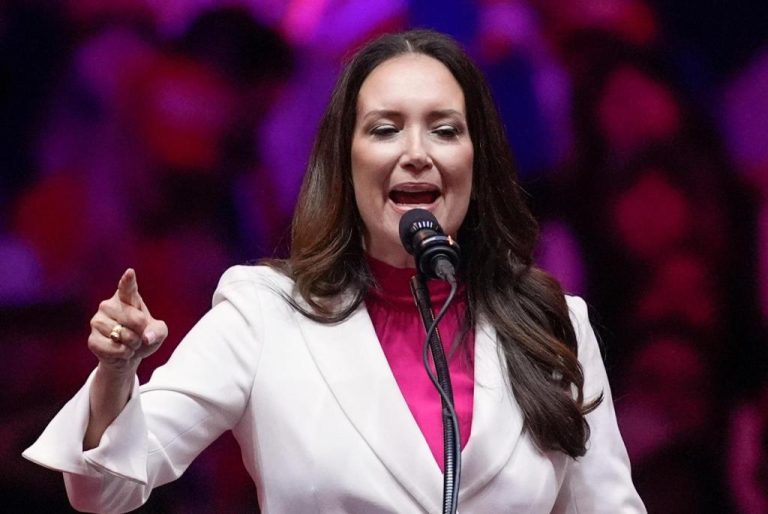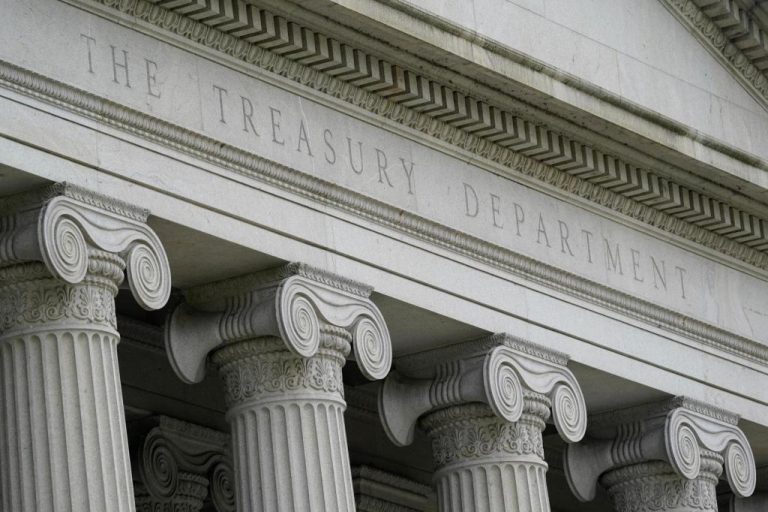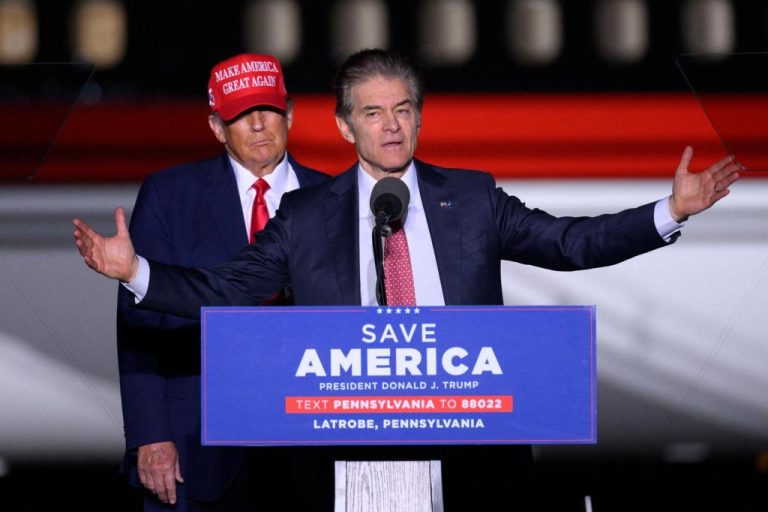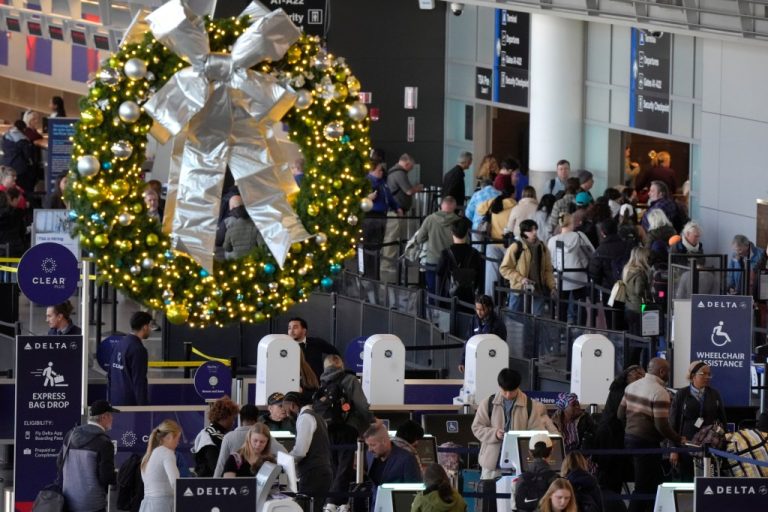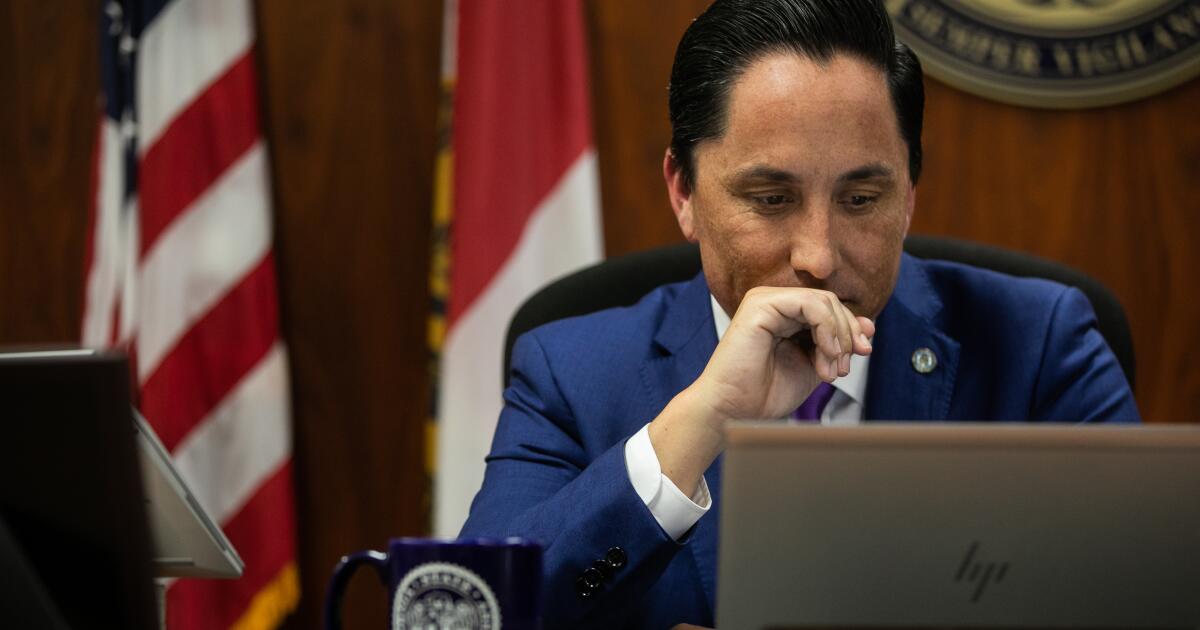

San Diego Mayor Todd Gloria will release a proposed budget Friday that increases spending on homelessness and flood prevention but cuts free city Wi-FI, help for immigrants and other low-profile programs.
The mayor’s proposal would avoid much deeper cuts with one-time moves like canceling $30 million in scheduled reserve contributions and borrowing $25 million to fund infrastructure projects instead of paying for them up front.
Other one-time moves include using $15 million in Housing Commission reserves to pay for ongoing city homelessness programs, and canceling the city’s contribution to its climate equity fund for one year to make $8.5 million available for other expenses.
Such one-time moves, where ongoing expenses aren’t supported by ongoing revenues, are generally considered bad budgeting practice by organizations that advise government agencies.
The mayor said these moves make sense because he doesn’t want to reverse progress on issues like homelessness and street paving. He also said he is optimistic that tax revenues will rise later this year as inflation eases and that that could mean lower interest rates.
“I’d rather not have one-time solutions for ongoing costs, but the fact is we’re in a difficult position,” Gloria said.
City finance officials say additional reasons these moves make sense for San Diego are two proposed tax increases that could appear on the November ballot and could, if passed, raise annual city revenue.
Those measures include a proposed one-cent city sales tax hike that would generate $400 million annually, and a stormwater fee hike that could generate about $100 million for flood prevention.
The mayor’s proposed budget would cover the fiscal year that starts July 1. Finance officials said deeper cuts would be necessary the following fiscal year if voters reject the two city revenue measures.
That’s because San Diego has what officials call a structural deficit of roughly $200 million in its annual general fund budget of just over $2 billion. The structural gap has been partly masked in recent years by $550 million in federal pandemic aid the city received, which has completely run out.
The mayor’s proposed budget would widen the $200 million structural gap a bit further by adding about $18 million for 1,000 new homeless shelter beds and a new designated parking site for people who sleep in their cars, and by quadrupling annual funding for emergency flood prevention from $20 million to $80 million.
But his proposed spending plan, which will be debated this spring by the City Council and finalized in June, closes that gap with a combination of strategic cuts and one-time financial moves.
The cuts, which don’t call for any layoffs to the city’s 11,000-member workforce, include eliminating the city’s Office of Immigrant Affairs and its Cannabis Social Equity Program.
The three-employee Office of Immigrant Affairs helps immigrants and refugees with paperwork and other challenges. The cannabis program, which is still being developed, would help people disproportionately affected by the war on drugs open dispensaries.
Other cuts include reductions in funding for SD Access 4 All, a program that provides free WiFi and loaner laptops at city libraries, recreation centers and elsewhere. It’s considered particularly important in low-income areas.
Funding for events and programs at libraries and recreation centers would also be reduced by $2.5 million total under the mayor’s proposal.
While the budget mostly avoids cuts to public safety efforts — police, lifeguards and firefighters — it would save $1 million by making one of the city’s two firefighting helicopters non-operational for the half the year when wildfires are less likely.
The proposal would also save $400,000 by shrinking the number of annual fire academies from three to two.
Gloria would save another $4 million by shrinking the number of recruits for each of four annual police academies from 43 to 30. City officials said this makes sense because there has been a downward trend in the number of recruits at police academies, including only 25 participating in the most recent one.
There would be $18.5 million in additional savings across several departments created primarily by a citywide hiring freeze, elimination of some training programs, delaying purchase of some supplies and making administrative changes.
The mayor’s budget prioritizes cuts that could be restored quickly and easily if voters approve one or both of the possible November ballot measures. The council is expected to decide this summer whether the measures will make the ballot.
Gloria said avoiding drastic cuts that could set city services back for years is a key reason his spending plan relies on many one-time financial moves. He pointed to the difficulty the city could face in reopening a library branch after it has been completely shuttered.
“We are calling this the ‘protecting our progress’ budget,” the mayor said. “We don’t want to let up on our priority areas.”
The one-time moves include canceling an $8.4 million reserve contribution for the ongoing fiscal year and a $21.4 million reserve contribution scheduled for the new fiscal year.
Those moves would delay even further San Diego reaching its goal of having 16.7 percent of its annual budget in its reserve fund, which amounts to two months of expenses. The mayor’s proposal would leave the city with $207.1 million in reserves — only about 9.6 percent of the $2.15 billion budget he’s proposing.
The move would mark the second time in less than two years that the city has softened its commitment to the goal of 16.7 percent, which is recommended by the Government Finance Officers Association.
In late 2022, the City Council approved a plan that delayed from 2025 to 2030 achieving the goal. For this proposed budget, the amount of reserves needed would be $359 million.
The mayor’s proposal would delay that goal indefinitely. It would also mean that the city will have only increased its reserves by $1.5 million over five the fiscal years from 2021 to 2025.
Gloria defended that move, stressing that his budget wouldn’t use any reserves — it would just give the city two “reserve vacations” during a tough financial time. Not tapping into reserves makes it likely the city will retain its strong credit rating, he said.
“This is a fiscally prudent middle path,” he said.
Another one-time move would be financing $25 million in already-approved capital improvement projects by selling lease-revenue bonds, which would free up that amount in cash to pay for other things.
The mayor also proposes to take $15 million from the city’s Housing Commission — mostly from the commission’s reserves — to pay for ongoing city homelessness efforts.
The move would allow San Diego to maintain all its existing homelessness programs and add a new 1,000-bed shelter proposed for Kettner Boulevard north of downtown. The budget calls for $110 million in homelessness spending in fiscal 2025, up from $92 million during the ongoing fiscal year.
With the Housing Commission contribution, the city’s contribution would be only $95 million — $3 million more than the ongoing fiscal year.
The mayor also proposes to shift how the city typically uses money in its Infrastructure Fund, which is created during each budget season based on projected increases to city tax revenues in the adopted budget.
Estimated revenue increases this year require the city to put $19.7 million in the fund. The mayor would do that — but he wants to spend the money on operations and facilities maintenance instead of on capital projects, as it is usually spent.
City voters created the Infrastructure Fund in 2016 when they approved Measure H. The ballot language says the money must be spent on “the acquisition of real property, construction, reconstruction, rehabilitation, repair, and maintenance of infrastructure.”
The mayor also proposes waiving the annual contribution to the city’s climate equity fund, which pays for projects to help make low-income communities more resilient to climate change. That would give the general fund another $8.5 million.
Another proposed move is placing in the general fund $7.7 million in new settlement money from Monsanto, which is paying government agencies compensatory damages for chemicals it manufactured that harmed the environment.
The mayor would also place in the general fund $5.8 million from the sale of downtown’s Tailgate Park. The money has been earmarked for Bridge to Home, a gap-financing program for income-restricted housing projects.
Another move by the mayor that would help close the deficit is revising revenue projections for the end of the ongoing fiscal year. Those projections had been revised downward this winter, but are now being revised upward by $13.2 million in the mayor’s new proposal.
This year’s budget gap could have been worse if the city’s pension board hadn’t approved new calculations last month of the city’s pension debt that lowered by $27 million the annual payment due this July from the general fund.
City finance officials had requested additional calculation changes that would have lowered the payment even further, by about $100 million, but the pension board rejected those.
One change that’s certain to shrink the city’s structural deficit is voter-approved Measure B, which allows the city to start charging single-family homes for trash and recycling services starting in fiscal year 2026. The change is expected to boost the general fund by about $80 million a year.
The mayor’s proposed budget is based on an expectation that property tax revenue will rise from $759 million to $807 million during the new fiscal year. Hotel tax revenue is expected to rise only slightly, from $173 million to $174 million. Sales tax is expected to drop, from $402 million to $393 million.
Franchise fees from cable and power companies are expected to rise from $110 million to $124 million, primarily because San Diego Gas & Electric is raising its rates.
The size of the general fund would rise under the mayor’s proposal from $2.08 billion to $2.15 billion, an increase of 3.2 percent.
The budget doesn’t sharply increase funding for street paving, something city officials have called for since a comprehensive evaluation of the condition of city roads was unveiled this winter.
But the budget does include $140.7 million for street repairs, which would let the city pave 15 more miles of streets in the next fiscal year than the last — 60 miles in fiscal year 2024 versus 75 in fiscal year 2025.
The budget also includes money for more design work on future paving projects, which could allow the number of miles paved in fiscal year 2026 to increase to 105.
The council’s Budget Review Committee is scheduled to receive detailed reports on all of the proposals in the budget during meetings on May 1, 2, 3, 6 and 7.
The council discussed this winter possibly taking more power over the budget from the mayor.


